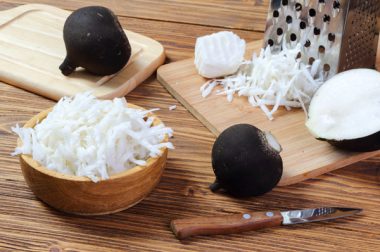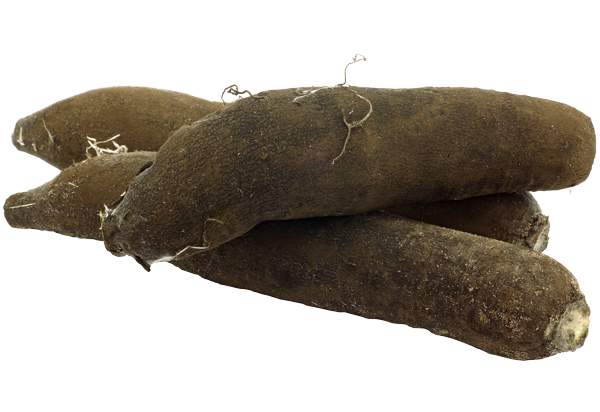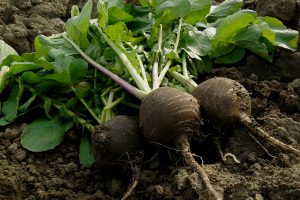Recipes we love
See all recipesBlack radish salad
If the radishes are very big, cut them into slices and lightly salt to soften. Leave to stand for 30...
HEALTH
BENEFITS
Rich in fiber and a source of vitamin C !
Black radishes are delicious vegetables, which are unfortunately somewhat forgotten. Their unique flavor and light spiciness makes them stand out. Some people use them to stimulate digestion.
Black radishes are also :
- Rich in fiber
- A source of vitamin B3(niacin), which can reduce fatigue, and plays a role in maintaining healthy skin and in energy metabolism!
- A source of vitamin C, which is a very important vitamin, as it regulates the immune system, supports the nervous system to function well, can reduce fatigue and protect the body against oxidative stress.
NUTRITIONAL
COMPOSITION
WHEN IS THE RIGHT
TIME TO EAT THEM?
Fall and winter.
Black radishes are an excellent example of off-season vegetables. They are in season from September to January.
VEGETABLE PATCH
OR URBAN BALCONY?
Store your black radishes properly:
- In the refrigerator, black radishes keep for 2-3 days in the vegetable drawer. To store in optimum condition, wrap them in a damp tea towel. Otherwise they quickly lose their crunch.
CHOOSING
AND STORING BLACK RADISHES
Choose your black radishes well :
- They should be firm and uniformly black in color.
Pour bien conserver vos radis noirs :
- Au réfrigérateur: 2 à 3 jours dans le bac à légumes, car il ramollit rapidement.
ANTI-WASTE TIPS
Is your black radish too soft to eat raw? Then make a black radish and honey jam. It is also very good with ginger, and can be used to pep up soups and purées!
Don’t throw away black radish leaves either, as you can use them in salads and soups. Be sure to wash them thoroughly before chopping.
WHAT IS
THE environmental IMPACT?
The Product Environmental Footprint (PET) tells us more! This is a score, calculated by Agribalyse*, which takes into account all of the stages of a vegetable’s life cycle: how it is grown, the impact of transport and processing, and so on. The lower the score, the lower the environmental impact.
- Black radish, raw: 0.06
- Beefsteak, raw: 2.70
*Data taken from the Agribalyse database, which records the environmental score of food items. This unique score is an average of 16 indicators, calculated according to the European PEF methodology. It does not correspond to an environmental label or “eco-score”.
CO2 equivalent: For 100 g of raw black radish: 0.06 kg of CO2e, which is the same as 2 g of raw beefsteak.
TIPS
AND TRICKS
How to prepare black radishes
It takes a matter of minutes! Just wash them to remove any remaining soil. You can leave on their black skin, which contrasts beautifully with the white inside. It’s quick and easy!
Black radishes go well with…
Raw: You can eat black radishes grated, made into “noodles,” or cut into rounds; plain, with salt, with a remoulade sauce, or mixed with other raw vegetables. They add their spicy flavor and a bit of novelty to composed winter salads. Black radishes pair well with scallops, sheep’s milk cheese, feta, beetroot, sardines, arugula, smoked fish, and more. And have you ever tried black radish pickle?
Cooked: They are a perfect way to add some spice to mashed potatoes or pumpkin soups, or they can be made into original homemade chips.
CAN EVERYONE
EAT THEM?

Young children
Young children can try black radishes starting at 18 months! It’s easiest when they are cooked and then added to purees or soups to liven them up a bit, so the children can get used to the spicy taste.
And everyone else…
The spiciness of black radishes may take some getting used to, but their crunch is a good reason to try them out…and like them. People who are particularly sensitive to spice can steam them before using them in recipes.
See plenty of other tips for encouraging children to eat vegetables
WHERE DO THEY COME FROM?
ORIGINS AND VARIETIES
Origins
The main producers of black radishes are China, Japan, Austria, Germany, Italy, France, and the Netherlands.
Varieties
Black radishes are some of the large radishes and turnips in season in summer, fall or winter. Two main varieties are cultivated: the Noir Long Maraîcher and the Noir Gros de Paris, meant to be stored over the winter. These varieties do particularly well as winter crops, because with their white, firm, and compact flesh, they can be stored throughout much of winter without sprouting or becoming hollow.
Today, variants with white roots also exist, including in Germany, where they are known by the names Rettich and Radi. The black radish harvested in summer is white in color and less spicy than the winter black radish.



 Flageolet Beans
Flageolet Beans  Fava beans
Fava beans  Vegetable garden: growing horseradish
Vegetable garden: growing horseradish 










